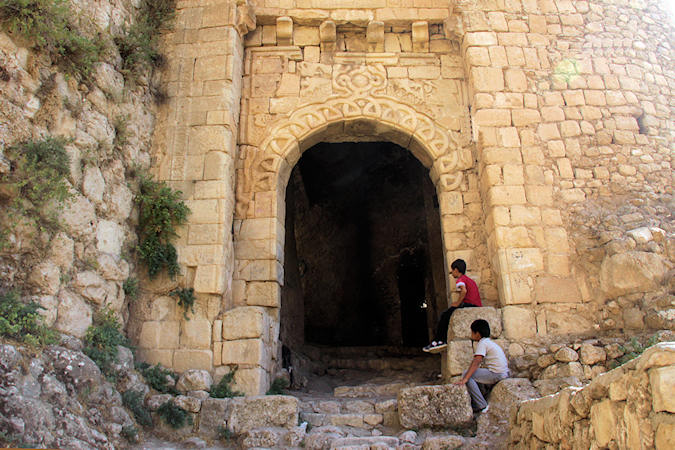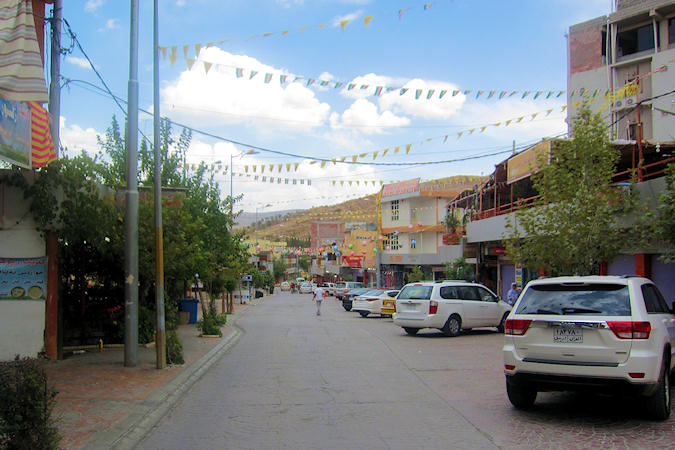Iraqi Kurdistan
Things to DO
Dohuk
 |
|||||
Located on the international highway between Iraq and Turkey, Duhok has become a nodal point
for trade and communication.
This advantageous geography provides its citizens with easy access to major neighboring coastlines,
historical mountain sites and valleys, the countryside and urban hustle and bustle, with ready made
opportunities for recreation, travel and employment.
Duhok city is a multi-cultural, multi-religious community with a predominantly Kurdish population.
Muslims, Christians, and Yezidis live side-by-side in harmony, merging together to recognize each others'
many traditional festivals, cultural events and religious holidays in a spirit of friendship and
celebration.
The majority of the population speaks Kurdish - the predominant language throughout the Kurdistan Region
Lalesh
Hidden in a deep, green valley, Lalish is the most sacred place on earth for practitioners of the
Yazidi faith. Yezidis are a Kurdish religious minority of a few hundred thousand souls, living mainly
in Northern Iraq, as well as Syria, Turkey and the Caucasus. Yazidi religious practices have been described as
a blend of Eastern religions with hints of the ancient Zoroastrian and Mithraic practices, as well as elements
of Christianity, Judaism and Islam. All the monotheistic prophets are recognized, but Abraham and
Noah are especially venerated.
 |
|||||
The sacred history of Lalesh begins with the arrival of the Yazidis’ patron deity Tawusi Melek,
the Peacock Angel, who first arrived on Earth when the planet was still barren and constantly besieged
by earthquakes and volcanoes, Tawusi Melek was sent to Earth to remedy the situation and make the planet one of
the most beautiful in the universe. Landing as a peacock at Lalesh, Tawusi Melek succeeded in stopping the
Earth’s quaking and then he covered the planet with his “rainbow” peacock colours.
The Yezidis hold that Tawusi Melek is as fire with two dualistic elementary abilities: Fire as light, but
also fire to burn: The good and the evil are one and the same Person.
Simultaneously is a human being itself a mixture of two powers: good and evil, i.e. every Yezidi has a part
of Tawusi Melek in himself.
The most important ritual is the annual seven-day pilgrimage to the tomb of Sheikh Adi ibn Musafir.
The Yazidi consider him an Avatar of Tawusi Melek. He reformed the religion radically in about 1162.
Before going into the main entrance visitors are expected to take off their shoes. A snake sculpted
on stone sits at the main entrance; the top is a large arch, ancient and majestic. The snake has close
associations with the story of Noah. It is said that when the Ark sprang a leak, one of the snakes on
board coiled its body into a bung to close it up.
 |
|||||
Proceeding to the nave of the Sanctuary one finds several tombs belonging to the earthly incarnations of
the Seven Great Angels. Different coloured silks (the seven colours of the rainbow) cover the tombs, and
these are knotted several times.
Those pilgrims who seek assistance from the Seven Angels in solving their problems tie a knot (or knots) in
one of the silk rags while simultaneously untying another one. The untied knot ensures that a previous
pilgrim that tied the knot will soon find a rapid solution to his or her problem.
Attached to the chamber of Shiekh Adi’s tomb is the cave of the “wishing rock”. Legend has it that
if one manages to throw a piece of cloth on top of this rock over a lit candle one’s wishes come true. This
is said to be the rock that Sheikh Adi magically elevated in the air to convince some Sufi sheikhs of his
divinity.
Outside of the Sanctuary one can find other shrines dedicated to the Seven Great Angels and other
important deities dotting the Holy Valley of Lalesh.
One of the important shrines is the White Spring, so called because at the time of the Flood (when
Noah's ark was circling around) its water is said to have remained clean and clear, rising as a white tower
towards the Heaven. This is where Yazidi children are commonly baptized, or the water is collected in a jar
and taken outside of Lalesh for baptisms.
Amadiya
 |
|||||
Amadiya’s four neighbourhoods - Sardabki, Maydan, Hamam and Ayoum - occupy a mountain top and a total
area of around only six kilometres in a horse shoe shape. It is encircled by a wall and, although authorities
removed part of the city’s fortifications in 1938 to allow cars access, its main road actually circumnavigates
the city.
Although some visitors have said that it looks much like any other Iraqi town, others say that, from a
distance, it looks like a magical city 1,400 metres above sea level, dancing in the clouds.
The city was once apparently home to historical figures such as the prophet Ezekiel and the
three wise men from the Christian Bible.
In Judaism, Christianity and Islam, Ezekiel is acknowledged as a Hebrew prophet. In Judaism and Christianity,
he is also viewed as the author of the Book of Ezekiel that reveals prophecies regarding the destruction of
Jerusalem.
 |
|||||
The ancient city of Amadiya dates back at least to the Assyrian era.
The city was once a high-walled citadel, but all that remains is the huge, marble Eastern Gate. This gate
(Bab Zebar), was built in 500-600 AD and is 4m wide and carved with intricate bas-reliefs.
The city is a mix of Muslims and Christians and there are several fine churches in town.
The most visible landmark is the 30m high minaret of Amadiya Mosque, near the centre of town and built
by Sultan Hussein Wali. It’s about 400 years old and pockmarked with bullet holes from the Kurdish Civil War.
It’s possible to climb the spiral staircase to the top of the minaret, if you can find the imam who holds the
key.
Amadiya was also famous for its silk industry and was part of the southern Silk Road, the famous trade route
stretching from Asia to Africa.
Barzan
 |
|||||
Barzan is the birthplace of Kurdish leader Mustafa Barzani. Mullah Mustafa Barzani was a
“general” when the only “Kurdistan Republic” in history was announced in the Iranian city of
Mahabad, with the support of the Soviet Union, on January 22, 1946. After the collapse of the eleven month
old “state,” he went on to found the Kurdistan Democratic Party in 1946.
Exiled for 12 years, Barzani returned to Baghdad in 1958 and fought in the mountains against the Baath army
from 1961 to 1971. Taking refuge in Iran with the support of the United States, Mullah Barzani died in 1979 at
a hospital in America, where was receiving treatment.
The remains of Mullah Barzani lie in a grave made from village rocks, next to his son İdris Barzani,
who died from cancer immediately after his father's death. İdris Barzani is the father of the Kurdish
administration's Prime Minister Nachirvan Barzani.
The Barzani Memorial Center is going to be built around the grave of the Barzanis. It will include
a mosque, a museum, an amphitheater and a guesthouse.
Rawanduz
The northeast corner of Iraqi Kurdistan is an unheralded area of beauty marked by cascading waterfalls, soaring snow-capped mountains, deep gorges cut by raging rivers, rolling green hills and lush valleys. It is, without a doubt, the most beautiful and awe-inspiring place in Iraq.
 |
|||||
In 1928 New Zealand a engineer Sir Archibald Milne Hamilton was commissioned to build a road from the
Kurdish capital of Erbil to Haji Omaran on the Iranian border.
This ‘short cut’ allowed the creation of a
strategic and direct overland route from the Mediterranean cities of Beirut and Alexandretta (now Iskenderun)
to the Caspian Sea, Tehran and on to India.
Hamilton completed his road in 1932 and detailed its construction in his travelogue, Road Through
Kurdistan.
The Hamilton Road runs parallel to the river past high, red limestone walls that rise almost vertically from
the canyon floor.
Halfway along the canyon is Gali Ali Beg Waterfall. The waterfall is Iraq’s most
famous, appearing on the back of the ID5000 note, and the falls tumble 80m into a frigid tidal pool that
offers wading possibilities.
But will the scenery survive, course nowadays the place is on tourism. !!!!
 |
|||||
Although The Pank resort in other places would not specifically stand out, here almost make you forget
that you're in war-torn Iraq.
Holiday homes in the style of the Alps with the mountains of Kurdistan in the background. The toboggan is
a popular attraction.
The Pank tourist Resort, which was opened in 2007 by Hazem Kurda, a former refugee of Saddam Hussein's regime,
is the first such resort in Iraq. It includes a ferris wheel and other rides, including a toboggan.
When complete it will include a five-star hotel, restaurants, swimming pools, saunas, tennis courts,
helipads and mini golf.
And the newest plans even go further, making it a Dubai in contra-reverse by building two water dams to
create lakes and islands. The total area will be more than 40.000 square meters.
Shaqlawa
 |
|||||
Due to its cool weather during summer, Shaqlawa is visited annually by thousands of tourists from other
parts of Iraq.
Shaqlawa High Street is dominated by touristic restaurants, cell phone shops, clothes shops and shops
selling traditional sweets and nuts.
There is a vary famous sweet in Iraq called "mann wa salwa" - a mixture of divine sweets and jelly
beans - and the shop keeper told me that this is the manna that fell from heaven.
The ropey stuff hanging from the ceiling looks like sausages, and is called "sujki" which means
sausage. But in reality they are sweet and nutty; the white ones are made from flour and milk and filled
with wallnut, and the black ones are made from gelled grape molasses and stuffed with wallnuts.
"qamareddine" are made with apricots and pears and sour prunes.
Dukan
 |
|||||
The village of Dukan is as simple as it gets. Stretching along the river wizzed out by the
dam, the town has very few facilities and even fewer attractions. But the scenery is nice.
Lake Dukan is the largest lake in Iraqi Kurdistan. It is a reservoir on the Little Zab created by
the construction of the Dukan Dam. The Dukan Dam was built between 1954 and 1959 as a multi-purpose dam
to provide water storage, irrigation and hydroelectricity.
The surface area of the lake is 270 square kilometres.
The inhabitants of some 50 villages in the flooded area, around 1.000 families, were resettled to the
west of the lake